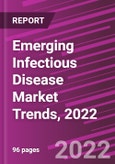The search for the next large-scale emerging disease was on before the COVID-19 pandemic. Respiratory diseases were among those suggested by Kalorama Information and other outlets and medical associations as possibilities for the next threat. The search is constant and is by no means limited to respiratory epidemics. As the recent monkeypox concern has demonstrated, little-known pathogens can emerge and become large health threats. This necessitates the development of tests at laboratories. For business planners, it’s worthwhile to have a resource describing the possible next pathogens of serious concern.
Emerging Infectious Disease Market Trends, 2022 is designed to provide a substantial look at Emerging Infectious Disease Trends with market numbers for significant categories.
This report includes:
- The Market in 2022 and the Forecast for 2027 for Diagnostics for Emerging Infections
- Discussion of Scores of Emerging Infectious Diseases of Various Categories Including:
- Viral
- Bacterial
- Mosquito-Borne
- Tick-Borne
- Animal-Borne
- Water/Fecal Transmission
- and Other Diseases
- 2022 Market Estimates for:
- Tuberculosis
- Malaria
- Lyme
- Dengue
- Other Emerging Diseases
- Further Market Breakout for Mosquito-Borne and Tick-Borne Diseases
- Diseases Identified by Major Health Agencies and Governments
- The Need for Mosquito Control, Tick-Borne Disease Awareness, the Threat of Island Hopping Diseases and Other Trends
- Diagnostic Products on the Market to Test for Emerging Infections
Why is it important to examine the world of emerging infectious diseases? In a 2015 TED Talk, Microsoft creator Bill Gates warned that there was a lack of preparation for a viral epidemic. He predicted that it would be “microbes, not missiles” that would cause significant harm to humans. Now with a global focus on testing, Kalorama’s update on all of the other diseases that could spread widely seems relevant. It’s not to say that every disease will be like the COVID-19 pandemic - not all will be respiratory threats that can spread quickly. Some pathogens spread through contact or insect vectors, slower but often steadier pattern. Vector-based tests such as Zika and malaria remain worrying and new diseases through that transmission method are troubling. And non-respiratory diseases such as Ebola can still spread quickly from person to person if not tested for and treated quickly.
Fortunately, the IVD industry is ready and companies have the capacity to identify antigen targets and viral or bacterial RNA to be able to build high-sensitivity diagnostic products and produce tests at an ever-increasing rate. This report covers their efforts with existing emerging diseases.








